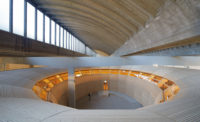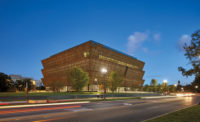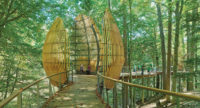Editor's Note: The Burke Museum is reopening to the public after being closed by the pandemic on September 22, 2020. Read more about their reopening protocols, and watch a video below about the institution that features interviews with Tom Kundig and Julie Stein, the Burke’s executive director.
Unlike the typical museum model, in which exhibition and back-of-house spaces are separated, the recently opened 105,000-square-foot Olson Kundig-designed Burke Museum of Natural History and Culture—located on a prominent corner of the University of Washington’s Seattle campus—showcases gargantuan fossils in bare, daylight-infused galleries. Throughout the warehouse-style building’s three levels, these striking display rooms mingle with fully-glazed research laboratories, workrooms, and interactive learning alcoves, giving visitors visual access to the preservation process, and encouraging a more accessible educational environment.
Additional Content:
Jump to credits & specifications
According to the museum’s director, Julie Stein, transparency was central to the project’s vision. Previously, the Burke had been located next door in a 1962 structure with only two galleries—compared to the new building’s six—and the bulk of the institution’s 16 million biological, geological, and cultural objects were hidden from view. “At the old museum, I’d take visitors down to the basement to see the students and researchers working with the collections,” says Stein, “People had no idea all of that was down there—it was like a secret world.”
More critically, the former building was grievously inadequate. It lacked proper temperature controls, so objects were placed in metal cases with gaskets to protect them from rapid changes in humidity, taking up already limited space. In the early 1990s, the Burke, which is fiscally administered by the university and funded in part by the state, had already run out of room—it wasn’t until 2009 that it was able to pull together the resources to put out a request for proposals. Tom Kundig was selected because he “truly understood what we were trying to attempt,” Stein says, “which was a building that invited people into nature. He talked about growing up in Spokane with a true love of the outdoors, of rock climbing, of the forest, and it really resonated.”
Although Kundig is a staunch advocate for adaptive reuse, the board was adamant about constructing a larger building for the $100 million project. Kundig’s approach for the new glass-and-steel structure, which has 66 percent more space than its 66,000-square-foot predecessor, was to make it as simple as possible — “a big rational box,” as he puts it, that would be easily adaptable for future growth. “It was not a stylistic endeavor, but a scientific one,” he says.
Inside the building—which, located on a sloped site, features a lower lobby in addition to its three floors—the architecture is minimal, allowing for the objects and activities to be at the foreground. The façade is fully glazed at the lobby levels, connecting the museum to the streetscape, while the upper levels are clad with swaths of sustainably engineered southern pine. A shed roof inspired by traditional Coast Salish dwellings nods to the institution’s Northwest identity.
The specific placement of the museum departments amongst the galleries was determined by the wants and needs of each division; since paleontology and archaeology had been in the basement for 50 years, they jumped at the opportunity to be near the skylights on the third level, according to Stein. The culture division, which comprises delicate artifacts that can be easily damaged by light, such as silkscreen prints, ceramics, photographs, and textiles, is located on the first level, away from exterior walls, leaving biology on the second. The decision to have researchers on view was very thoughtfully considered. In the old Burke, glazed laboratory prototypes were constructed to test out how workers felt about being exposed to the public. The staff eventually acquiesced to the condition, the only caveat was that the museum would have to hire more researchers to work on the weekends: “If the lights are off, we are not fulfilling our promise to the public,” explains Stein.
On the site of the now-demolished old structure, a garden and programmable outdoor learning areas help to announce the museum’s presence. Whereas the former Burke was hidden within its urban block, Kundig’s design announces the instituion’s offerings with what Stein calls the “jewel box”—the fully glazed southwest corner that beckons passersby with massive whale and mastodon skeletons. “It sends the signal that this is a building full of magnificent objects that are awe-inspiring—and that you’ve got to come in and take a look.”
Virtually explore the space and see interviews with Tom Kundig and Julie Stein, the Burke’s executive director.
CreditsArchitect: Olson Kundig 159 S. Jackson St, Suite 600 Seattle, WA 98104 206-624-5670
Personnel in architect's firm who should receive special credit: Tom Kundig, FAIA, RIBA, Design Principal; Stephen Yamada-Heidner, AIA, LEED® AP, Principal and Project Manager; Edward Lalonde and Justin Helmbrecht, LEED® AP, Project Architects; Gavin Argo, Julia Khorsand and Olivier Landa, AIA, LEED® AP BD+C, Architectural Staff; Phil Turner, Gizmo Design
Architect of record: Olson Kundig
Interior designer: Olson Kundig
Engineers: Structural and Civil: Magnusson Klemencic Associates Mechanical: WSP Electrical: Stantec
Consultants: Landscape: Gustafson Guthrie Nichol Lighting Design: Niteo Specifications: City Specific Labs: BergerADAM Elevators: Lerch Bates Accessibility: Karen Braitmayer Building Envelope: RDH Museum Programmer: Walter Crimm Associates Gizmo Fabrication: Turner Exhibits Exhibit Design: Evidence Design
General contractor: Skanska USA
Photographer: Aaron Leitz |
SpecificationsStructural System Manufacturer of any structural components unique to this project: Structural steel utilizing SidePlate connections
Exterior Cladding Wood: Kebony / Pine River Group Moisture barrier: DuPont Tyvek Fluid Applied Curtain wall: Old Castle Other cladding unique to this project: Hardie Cement Board Panel
Roofing Other: Siplast Modified Bitumen
Windows Metal frame: Old Castle Curtainwall/Storefront
Glazing Skylights: Evergreen House Custom Framed Skylights with View Glass
Doors Entrances: Old Castle Metal doors: Curries Hollow Core Wood doors: VT Industries Architectural Wood Doors Sliding doors: Kawneer 1010 Sliding Door Fire-control doors, security grilles: McKeon Fire Shutters, Cornell Security Grilles Upswinging doors, other: Custom pivot, manual operated door at Café (Phil Turner Dedicated Door)
Hardware Locksets: Corbin Russwin Closers: Norton Pulls: Corbin Russwin
Interior Finishes Acoustical ceilings: Armstrong Ultima Suspension grid: Armstrong Silhouette Demountable partitions: Modernfold Cabinetwork and custom woodwork: ISEC Custom Cabinets Paints and stains: Sherwin Willians Wall coverings: Decoustics wall panels Paneling: Reclaimed Madrona wood, historic salvaged Boisserie panels (relocated from previous building) Plastic laminate: Formica in Black Solid surfacing: Lab Countertops – Duracon; Restrooms – Pental Quartz in Stormy Floor and wall tile: Dal Tile Composition 12” x 24” in Gesso; Dal Tile Modern 4.25” x 8.5” in Arctic White; Dal Tile Keystones Mosaic 2” x 2” in Desert Gray Resilient flooring: Roppe 4.5” no toe base in 175 Slate; Roppe 4” standard toe base in 175 Slate; Forbo/Marmoleum Sheet Flooring in Walton 171 Cement Carpet: Walk-off Mats – Construction Specialties Peditred Heavy Duty carpet in Graphite Special interior finishes unique to this project: Permalac coated steel at stair and guardrail; pre-cast concrete stair treads
Lighting Interior ambient lighting: Litelab track mounted accent lighting; Bartco mezzanine area light; GE Lumination lay-in troffer; Litelab clamp mounted accent lighting; Peerless linear pendant; Finelite linear lensed slot light; Lumenpulse LED wall graze; Lindsley Lighting decorative cylinder pendant; Philips Colorkinetics linear undercabinet light; Sistemalux track mounted accent lighting Downlights: Bartco linear fluorescent; Lithonia lensed LED striplights; V2 downlight cynlinder; Stonco Philips industrial style vanity light / elevator pit light; RSA recessed adjustable accent light; Kurt Versen recessed downlight; ETC source 4 par mcm; Birchwood Lighting strip mounted linear fluorescent; Prudential stair light; Senso Lighting recessed downlight Tasklighting: ETC theatrical / gallery project lighting; Vode Lighting white board light Exterior: Kim Lighting single head area light; Lumec Philips single head area light; BK Lighting cylinder light; Bega full cutoff area light Dimming system or other lighting controls: Fresco |






















Post a comment to this article
Report Abusive Comment